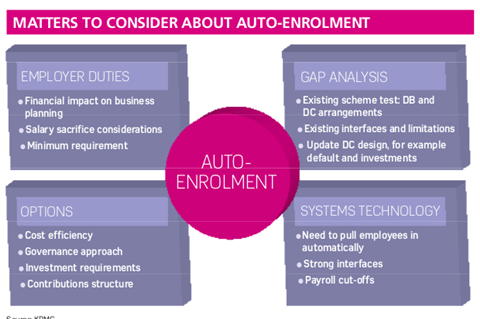If you read nothing else, read this…
- Employers should be realistic about their auto-enrolment budget.
- Planning ahead can help avoid potential problems.
- Postponement can give smaller employers breathing space.
More than half (55%) of employers that responded to Employee Benefits/Capita Pensions Research 2013 and have auto-enrolled their workforce recommend that smaller employers start planning for the process as early as possible.
A further 20% of respondents to the research, which was published in August, advise organisations to ensure that they and their payroll providers are clear about their respective duties, and 7% of the employers surveyed recommend setting up a governance committee.
But what other considerations are there for small and medium-sized enterprises (SMEs) that are yet to auto-enrol their staff?
Set realistic budgets
SMEs should be mindful of large employers’ opt-out rates when approaching their auto-enrolment projects, because this can help them determine a realistic budget for meeting their pension reform duties.
The Department for Work and Pensions has revealed that the average opt-out rate among early auto-enrolment stagers was 9%, according to its Automatic-enrolment opt-out rates: findings from research with large employers report, published in August.
This compares with employers such as McDonald’s Restaurants, which has seen just 2.4% of its hourly-paid employees and 2.7% of its salaried staff opt out of its pension scheme, as of May 2013.
Matthew Gregson, managing consultant at Thomsons Online Benefits, says: “Smaller employers should make sure they have realistic budgeting and have access to good-quality information on what opt-out rates are likely to be.
“The last thing they want is to make a projection of what the costs will be, only to find out it is two or three times that because opt-out rates have been so low.”
Manage expectations of workload
A number of employers are using auto-enrolment as an opportunity to introduce new employee benefits, or to realign their existing benefits package.
But Mike Carpenter, a director of financial planning firm Carpenter Rees, advises SMEs to manage their expectations about the workloads their employees and providers will take on.
He warns that introducing new benefits, or even a simple repositioning exercise, could be too burdensome for some SMEs.
“We would not suggest that an employer should change or upgrade its payroll provider during the process, unless there is a major issue with the provider,” he says. “It would put so much pressure on its payroll department that they would leave. It’s too much work to do.”
Beware capacity crunch
Pension providers and their resources are under increasing pressure to meet employers’ auto-enrolment needs and demands as an increasing number of organisations reach their staging date. This scenario, which has been dubbed the capacity crunch, threatens to reduce providers’ flexibility, according to Dale Critchley, pensions technical manager at Friends Life.
“For example, when an employer came to us with a fortnight to go before its staging date and said it needed to stage with us, we were able to put things in place very quickly and get people organised to change the pension scheme and put the technology in place,” he says. “But when we are dealing with hundreds of employers, that capability may not be there.”
To avoid this situation, Critchley advises SMEs to engage with their employee benefits teams as early in the auto-enrolment process as possible, and to assemble a suitable team to manage the project.
Allow sufficient time
SMEs should not underestimate the time auto-enrolment projects take to create, implement and execute.
Clare Abrahams, head of auto-enrolment at Lorica Consulting, says: “That’s the biggest issue we are facing with any size of employer: some don’t understand that there’s a lot of work involved, and that potentially means there’s going to be a lot of cost involved. Employers will have to take advice: legal, potentially, and consulting advice on auto-enrolment.”
Employers also need to consider the time involved in creating an audit trail of their project’s decisions.
Ian Chadwick, a senior consultant at Johnson Fleming, says: “If an employer decides that a group of employees don’t need to be assessed, or is making any decision about this, it should keep a log to show that it has made a decision, and how it has reached it.
“If there is a point of agreement in the future, particularly with The Pensions Regulator [TPR], the decision log will show that.”
Fleming believes a decision log can help to strengthen employers’ standing with TPR.
Consider postponement
SMEs can consider using a postponement notice before embarking on the auto-enrolment process. This allows employers to postpone auto-enrolment for a period of their choice of up to three months.
Gregson says: “The big thing [for employers] to learn is to properly use postponement to defer some of their work for a few months from their original staging date, and to smooth out the communication and initial administration of auto-enrolment.”
Postponement gives SMEs valuable breathing space to manage their auto-enrolment projects, but the option may not suit everyone, so organisations should make their own judgement about whether to use it.


Case study: LEBC stages early in order to learn
Independent financial adviser and employee benefits consultant LEBC auto-enrolled its workforce a year before its official staging date to ensure it fully understood the practicalities of the project, in preparation for helping its own clients through the journey.
LEBC auto-enrolled 40 employees in its pension scheme on 1 July and so far just one has opted out. It introduced the People’s Pension from B&CE for auto-enrolment purposes, which it offers alongside its existing group personal pension plan (GPP).
Glynn Jones, divisional director at LEBC, says: “We have gained experience from understanding staging for ourselves and that it is critical to have the various disciplines working together: payroll, pensions, finance and HR. We have staged a few employer clients now, and this experience has assisted us.”
LEBC communicated its auto-enrolment scheme via email. Messages focused on how auto-enrolment works, the identity of its pension scheme provider and what membership of the scheme means for employees, as well as on the fact that staff that remained in the scheme would see pension contributions deducted from their salary.
The organisation and its employees are each required to contribute 3% of an employee’s pay, which will increase to 5% for each over time.
Jones says the process was probably easier for LEBC because of its specialist industry knowledge. “But once we made the decision to stage early, it took four months of quite intense activity,” he adds.
“We know our stuff, and it still took us that sort of time and activity.”











